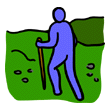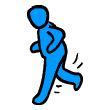Study the following pairs of sentences.
|
|
In the examples above, the subject pronoun (tsun, ch) follows the auxiliaries 'i and ni'. 'I signals that the event is happening in present space or present time. Ni' signals that the event was removed in space or time, so it sometimes (but not always) means past tense. However, to make it perfectly clear that you mean past tense, use ni'ulh as in the examples above. The suffix -ulh indicates past time.
Note: 'I is used much more frequently with tsun than ni' in these lessons, even when speaking about the past.
Pronunciation tip: Speakers often contract the auxiliary 'i and the question particle 'u to 'ii, and ni' plus the question particle 'u to nii.
| 'I 'u ch lhtsiw's? | "Are you tired?" |
| 'Ii ch lhtsiw's? | "Are you tired?" |
Either spelling is acceptable. We will often write 'i 'u and assume either pronunciation is correct, although we will always write the greetings 'Ii ch 'o' 'uy' 'ul'? and 'Ii tseep 'o' 'eli' 'ul'? as introduced in Lesson One.


